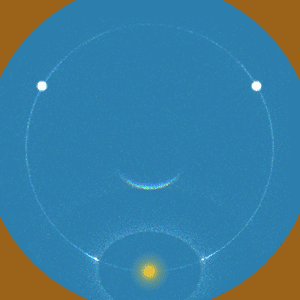The 120° parhelia, formerly also known as counter-sun parhelia, are located at a distance of 120° from the sun at sun height. They mostly occur together with the
parhelic circle and stand out as white bright spots from it. If the parhelic circle is also visible, the 120° parhelia are relatively easy to find. However, they do not always occur together with the parhelic circle. The parhelic circle can be created by both plates and column crystals. In contrast, the 120° parhelia occur only with plate crystals. With a parhelic circle created by column crystals, you will search in vain for the 120° parhelia. From the other halo types, it can be quite well determined by which crystals the parhelic circle is created. A bright
upper tangent arc or
circumscribed halo is a typical indicator of column crystals. The 120° parhelia can also occur without the parhelic circle. If bright
sun dogs are visible, the 120° parhelia are also likely.
The 120° parhelia are formed in
suspended plate crystals that are horizontally oriented. Sunlight enters the upper base surface of the crystal, is then reflected at an adjacent prism surface, and finally exits the lower base surface. The ice crystals must be relatively thick for this, otherwise only a few light rays are reflected at the inner prism surface.

